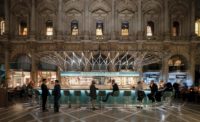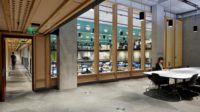Under most circumstances, Manca Studio’s renovation of the restaurant Oi Marì in Matera, a small city on a rocky outcrop in southern Italy, might be called minimalist. It features a concise material palette of rusty weathering steel, frameless glass and unfussy oak furniture; in the architects’ words, the project proceeded with the guiding aim of “subtraction, not addition.” But such a characterization underplays the warmth and wit of the intervention, and more importantly ignores the impact of its setting, in a labyrinthine limestone cave.
Additional Content:
Jump to credits & specifications
Like most of Matera’s ancient Sassi (rocks or stones) district, which tumbles down steep hillsides in Escheresque cascades of walls, stairs, and arching buttresses, the structure that houses Oi Marì comprises both man-made subterranean caverns excavated from the bedrock and additional aboveground elements formed from the same material, so that it is hard to tell where the terrain ends and building begins.
Manca Studio, led by siblings Alfredo and Marina Manca, has worked extensively in the Sassi, whose impoverished residents were evacuated to new-build apartments after the second World War, and which only began to be reoccupied in the 1990s. Oi Marì, named after a popular Neapolitan ballad, was an early example of this return. Established 19 years ago by four friends, it originally served traditional Neapolitan pizza, but the menu has subsequently broadened to include high-end cooking and fine wines, which prompted the $520,000 comprehensive overhaul.
From the outside, there’s little evidence of all that rebuilding. The restaurant is at the bottom of the gorge, and its only facade is a somewhat dilapidated single-story wall of stone blocks protruding from the stack of buildings that ascend the hillside. Cross the small forecourt edged with rosemary and lavender, and step through the inconspicuous entrance door, however, and a revelation awaits.
Standing at the reception desk, one’s eye travels through a long dining room that extends back into the rock in an enfilade sequence of interconnected chambers, demarcated by limestone arches originally constructed to support the undulating cave roof, which rises up to 17 feet. Oak tables draped in crisp white linens are dotted about the porcelain-tiled floor. White-shirted waiters glide between them, bearing delicate arrangements of grilled octopus and salt-cured cod. To one side, a small grotto has been converted into a 2,000-bottle wine cellar whose contents are exposed to view through a plate-glass screen, laser-cut to follow exactly the craggy surface of the cave. Around the walls, skeletal grids of Cor-Ten steel loosely frame the bar, or carry lighting fixtures and oak shelves on which pottery is displayed. These slender scaffolds are tied to the walls at just a few points, and, like the oak cabinetry’s, their warm, earthy tones harmonize with the pale, buttery color of the stone.
The careful articulation of every junction between the old and the new preserves the integrity of the existing stone structure and maximizes its visibility. Mirrored doors and partition walls are also used to divide spaces without creating visual distraction. In retrofitting the cave, the architects acted as if “on tiptoe,” says Alfredo Manca. The intention was “not to make any noise in a place that looks almost holy.” (Co-owner Luca Mangiapia intuits, from a corniced, pointed arch in the main dining room, that the cave might once have been a church, but the architects speculate that it was either a dwelling or a warehouse.)
Aside from cleaning the stone with high-pressure water jets, and minimal repair where necessary, the existing structure has been left almost entirely untouched. The soft calcarenite limestone—called tufo locally (though it is not volcanic, as is other rock of the same name)—is porous and enlivened by myriad natural holes. It also retains the traces of historic occupation. Walls are pockmarked by crude niches made for candles and by sockets for poles, to which animals were tethered. At the back of the main dining room, stairs ascend to a small chamber, just large enough for a single table, whose domed vault is peppered with pickax scars.
On either side of the main dining room, the restaurant has been extended into other networks of spaces that burrow eccentrically into the terrain and into adjacent structures. To the left of the entrance, behind an electrically operated oak sliding door, the gleaming kitchen has tripled in size to almost 1,000 square feet.
It contains one preparation area devoted to fine dining, with a glazed door to the street, and another dominated by a giant mosaic-tiled pizza oven. To the right, a small antechamber gives onto a narrow, smooth-walled passage that leads to an additional dining room and a wine-tasting “cantina” created from caves formerly used for storage.
One might expect these windowless underground spaces to feel gloomy or claustrophobic, but the architects’ close attention to ambience and environmental control ensures that this is not the case. The air pumped through floor grilles feels cool and fresh, and the electric light, from wooden fixtures threaded on looping black cables, lends welcoming warmth to the stone. The bespoke light fixtures are modeled on rolling pins used for pizza dough, which injects a humorous note but also has a more earnest intent, representing continuity between the restaurant’s past and future. Rootedness in culinary tradition remains important to Oi Marì, even as it seeks new expression for its ingredients. A similar spirit animates Manca Studio’s treatment of its spaces. “Throughout, we have tried to reinterpret the philosophy of the restaurant in an architectural key,” says Alfredo Manca. “From simple raw materials of the highest quality, we can reinvent traditional cuisine without erasing the memory of history.”
CreditsArchitect: Manca Studio, Rec.I Domenico Ridola ,Matera, www.mancastudio.it
Personnel in architect's firm who should receive special credit: Architecture Project Team_ Marima De Pace
Interior designer: Marina e Alfredo Manca
Engineers: Mechanical, Electrical, Plumbing: FluidoTecnica Grandi Impianti srl
General contractor: ILAN SOC. COOP
Photographer: Pierangelo Laterza |
SpecificationsDoors Wood doors: Ebanisteria Peragine
Interior Finishes FLOOR: Inalco Floor stairs: Marmeria Lionetti S.N.C. Di Ruggieri Giovanna & Figli
Furnishings Chairs: L'abbate, Framework Armchair Internal: Miniforms, Sergia Small Table: Hay Work Wooden Furniture: Ebanisteria Peragine (Design Manca Studio) Work in Glass: “Vetro&Vetro Di Eugenio Santoiemma” (Design Manca Studio) Corten Iron Works: Nuzzi Metal Design (Design Manca Studio) Kitchen Furniture: Omnia S.N.C. Di Demanco Nicola E La Battaglia Giuseppe Outdoor Furniture: EMU
Lighting Interior ambient lighting: Manca Studio Design Downlights: Flexalighting
Plumbing Plumbing: FluidoTecnica Grandi Impianti srl |













Post a comment to this article
Report Abusive Comment